MGrant’s Star Trek Tri-D Chess Rules
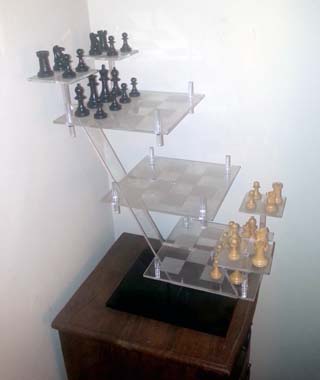
These rules are an elaboration of the rules printed in The Star Trek Star Fleet Technical Manual by Franz Joseph in 1975. With these rules I have attempted to lay out in precise detail how to play the game as I envisioned it. In creating these rules I have made every attempt to extend or wrap the classic game of chess around the beautiful multi-level Star Trek chess board and not to change Franz Joseph’s terse description of the rules.
In order to play chess on this board and for the game to still play somewhat like chess, certain characteristics of chess needed to be maintained and extended into a vertical dimension. For instance not only the ability for a piece to be situated above or below another piece, but to be able to use this position strategically. Adding a vertical dimension to a piece also required that the relative strengths of the pieces be perserved. This had to be balanced with keeping the game simple enough to play that there were no crazy moves that were difficult or impossible to visualize if they were valid or not.
Andrew Bartmess also put together a set of rules which he sells on his website. His rules are different. Though both his rules and these rules are based on Franz Joseph’s original text, they are not the same. Andrew’s rules were sold with a board manufactured by The Franklin Mint. His rules are copyright, I have not reproduced them here in whole or in part. I encourage you to visit his website for a copy of his rules (link at the bottom of the page).
The board
The board, if viewed from the side, gives 2 overlapping paths on each file to the other end of the board. This allows pieces to pass over one another (kind of like 2 levels in a shopping mall). The attack boards (the small 2×2 boards) add extra room to the corners of a board which can be moved around during play. These are well needed real-estate seeing as the main boards are 4×4, things get crowded quite quickly.
General
On any given level, pieces move as they do in regular chess. Moving up or down a level is similar to moving a square. Even though the color of the square does not alternate vertically, some pieces may move vertically, some must move to a different square in order to move up or down. This disparity allows the three dimensionality to be utliized to the fullest extent possible and retain the sense of classic game of chess.
Pieces which can move one or more squares at a time in a single direction (bishop, rook, and queen) can also move vertically in the same move.
When a piece changes levels, it may not return to or traverse that level in the same move.
A piece can only move in the direction it starts in. It cannot start moving in one direction upwards then reverse direction.
If there is a piece on the same level in front of a piece and a second piece on top of this piece, this situation does not block a piece from moving up in front of the piece above it (i.e. at an vertical angle). This is similar to horizontal situation where a bishop moving diagonally between two pieces.
The attack boards are extensions of the corner of the board where they are currently attached. Though they are physically close, you can not jump directly from white’s attack boards to the neutral board without passing through white’s level.
The Pawn
Arguably one of the more complex pieces to move even in classic chess. In general, a pawn can
- move forward one space
- can capture only on a diagonal, either on same level, one up, or one down
- can move forward 1 or 2 spaces forward on the first move
- on any forward move can move up or down one level (can not move vertically)
A pawn moving off an attack board always moves off the attack board down (or up) forward but diagionally as if it’s capturing. A pawn moving on to an attack board always moves up (or down) to the attack board forward but diagonally. It does not need to capture (but it can) on these diagional moves.
On an unmoved attack board pawn’s first move:
- either pawn must move down off the attack board diagonally
- on the pawn’s first move, the pawn can optionally move one extra space forward (this may be necessary if there is a pawn blocking it from moving off the board diagonally, the pawn must move in front of this pawn)
- it may capture a piece during this diagonal move off the attack board
- if it did not capture, it may advance forward one space to the third rank
There are 4 files in tri-dimensional chess but each file is doubled vertically in space (except for the first and last 2 rows). This rule for the attack board pawns allows all 8 files (2×4) to be filled.
The rule for en passant from classic chess is also preserved from classic chess. An opposing pawn may capture a pawn left or right (not diagonally) if that pawn took the option to move two spaces forward on the previous move. However, if the pawn was moved off an attack board in front of an unmoved pawn, you cannot take this piece en-passant because the second pawn behind it blocks you, you could take the pawn behind it normally though.
The Knight

The knight travels exactly as it travels in classic chess, as in an L shape. However in tri-dimensional chess, this L shape is extended into the third dimension by allowing the kinght to move up or down one level or stay on the same level. It can jump over or through pieces. For example:
- 2 spaces forward then 1 space left, staying on the same level
- 1 space forward then 2 spaces right, staying on the same level
- 1 space forward and up then 2 spaces left ending on one level up from where it started
- 2 spaces forward and up one level then 1 space to the right ending one level up from where it started
There must be board spaces (occupied or not) that the kinght travels over. The knight cannot traverse non existent board terrain. For example, a knight cannot move directly from the neutral level on to an attack board in its initial position because this implies moving through non contiguous board space.
The Bishop
The bishop always stays on the color it started on. As in regular chess, the bishop can move diagonally as many spaces as there are open in a straight line while ascending or descending. The bishop may also move vertically straight up or down. The bishop may move at an angle while ascending or all descending. All of these moves can be combined as long as there is an open path and it always travels on it’s color it started on and the move is one in one general direction as viewed from above.
It is possible for a bishop to be in a position vertically on top of (or below) a rook where the rook cannot take the bishop but the bishop can take the rook.
The Rook
The rook always moves left, right, or forward or back in the ranks and files of the board. The rook may not move directly vertically, it must always move at least one space in horizontal space. The rook may move in one direction ascending or descending as long as there is an open path.
It is possible for the rook to go all the way from it’s attack board to the other side of the board to the opponent’s attack board, if there is a clear path without returning to a level traversed on it’s path.
The Queen
The queen’s moves are the combination of the bishop’s and the rook’s. It can move in any direction, both vertically or on the same level as long as there is an open path.
The King
The king can move one space in any direction, vertically or on the same level. The king can move up or down one level vertically during a move. The king can move up (or down) a level and then forward, back, left, or right one space (i.e. at an angle but vertically).
The Attack Boards
The attack boards are extensions of the corner they are attached to. They do not add an intervening level between two levels. To hop off an attack board, the piece must be moved to the main level to which the attack board is attached and then continue to move from there (if such a piece can move more than one space in a turn.
If an attack board is occupied by a single pawn, the owner of that pawn may move this attack board. Attack boards can be moved to an adjacent pin forward, back, left, or right (but not diagonally across) on the same level. They can be moved up or down to the next closest pin on the next level.
When a player moves on to an empty attack board, they have the option of inverting the attack board while it is empty. Inverting an attack board on it’s own does not constitute a move and cannot be done on it’s own to avoid moving.
An attack board can be commandeered when the opponent moves a piece on to an empty board or captures the last remaining piece on the board.
Note that this will take 5 moves to invert an attack board and move it all the way to the far end of the board for a queen. It also involves needing two pawns aiding one another to invert the board.
- The attack board is moved forward one pin (assuming it is occupied by only one pawn)
- The pawn moves off the attack board
- The board is inverted and the second pawn moves on to the attack board
- The board is moved forward up/down to the next adjacent pin
- The attack board is moved forward
- The attack board is moved forward up/down to the next (far edge) pin and the pawn becomes a queen.
Casteling
As in classic chess, the king and rook to castle must not have been moved.
To castle on the king’s side (O-O), the king’s bishop and knight must have been moved and those squares open. The king moves to the king’s knight’s square and the rook moves to the king’s bishop’s square.
To castle on the queen’s side (O-O-O), the queen and the queen’s bishop and knight most have been moved and those squares are open. The king moves to the queen’s knight’square and the rook moves to the queen’s bishop’s square.
The king may not castle out of, or into check.
There is a nice advantage to casteling because it gets both the king and rook off the attack board in one move allowing this attack board to move that much sooner.
Queening a Pawn
If a pawn reaches the end rank of the opposite side of the board, it becomes a queen on the next move. A pawn which is on an attack board when that attack board is moved to the position on the opposite side of the board also becomes a queen. A pawn which is gets to the far side of the board and gets up on an attack board becomes a queen when it gets to the farthest rank of the attack board.
Summary
Those are the rules. You do not need to read any further to play the game.
If you would like to read how I arrived at these rules and why I made the perhaps seemingly random choices (which were not in fact!), please read the Analysis page.
For a notation which can be used with this game, please see the Notation page.
Other Versions of the Rules
I am not the only person to have thought up rules for this board. Andrew Bartmess also has a different set of rules. Please see his website at yestercade.net. The rules I have detailed above are different from Andrew’s. He took a different set of assumptions than I did when he designed his rules. I encourage you to go get a copy of his rules and let me know which ones you like best!

MGrant’s Star Trek Tri-D Chess Rules by Michael Grant is licensed under a Creative Commons Attribution 3.0 Unported License.
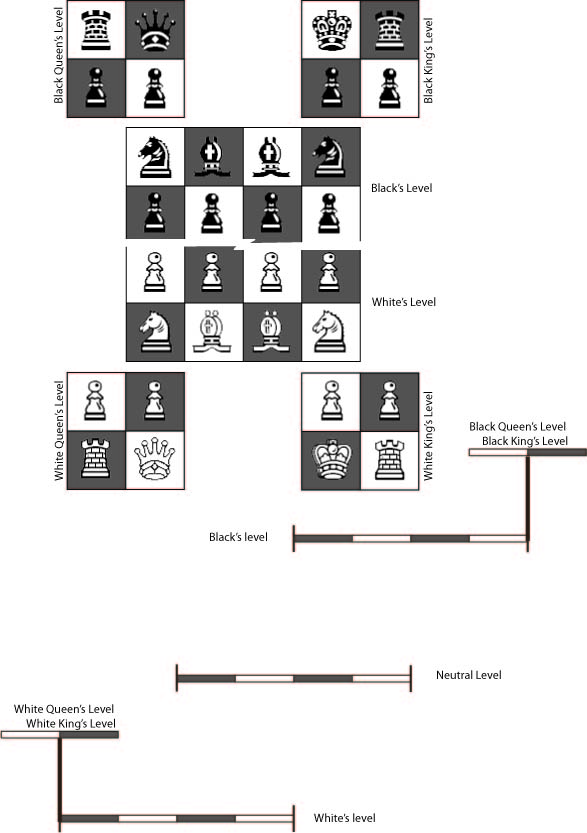
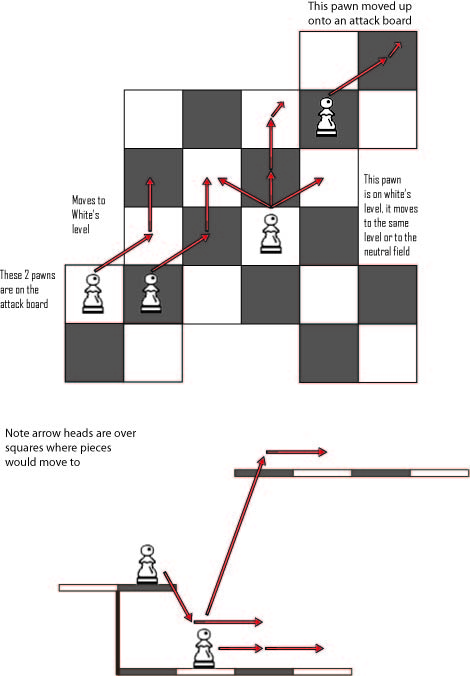
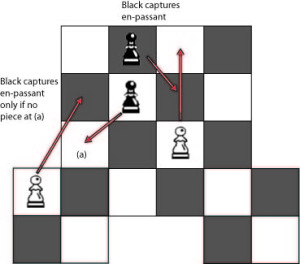

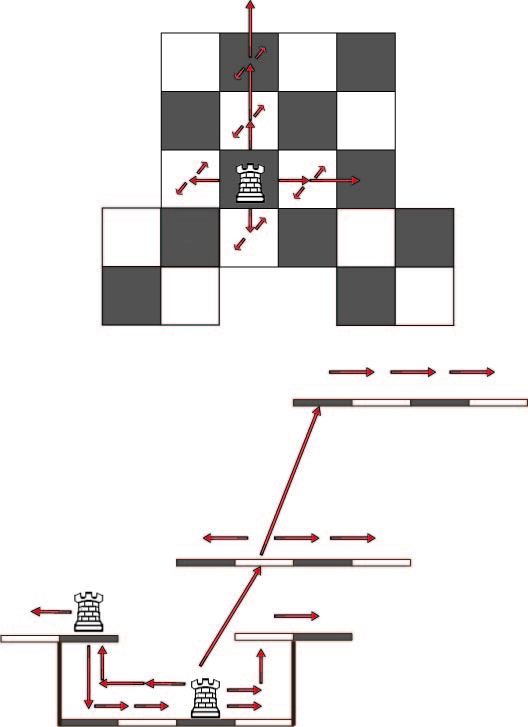
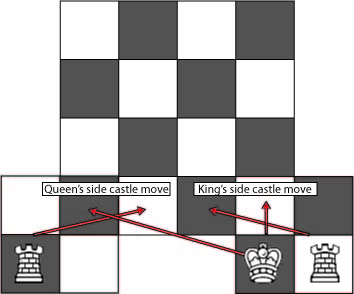
Hi there. Luckily stumbled across your site while I was researching tridimensional chess and I love your rules the most out of all the sets I have come across. You’ve elegantly solved much of the awkwardness of the game and I am looking forward to testing it.
I have a single question regarding Promotion. If a pawn is at the corner of the opposite attack board and the attack board is above it, does it upgrade or does it have to move onto the attack board to upgrade?
I ask because if it does not upgrade then if one moves the attack board it automatically upgrades.
Good question!
The pawn only needs to get to the last rank of the white or black’s level to be promoted. There is no need to go the edge of the attack board if it’s hanging out over the edge. Remember, these attack boards are almost as if they are directly on top of the 4 squares containing the bishop, knight, and 2 pawns.
Perhaps I glossed over it (everything else makes sense to me), but what is the purpose of inverting an attack board? Is there some special advantage that an inverted board gives you?
So that you can have 2 attack boards connected to a single corner. I didn’t make this up. It’s in the TV show and it’s also in the Star Trek Technical Manual description.